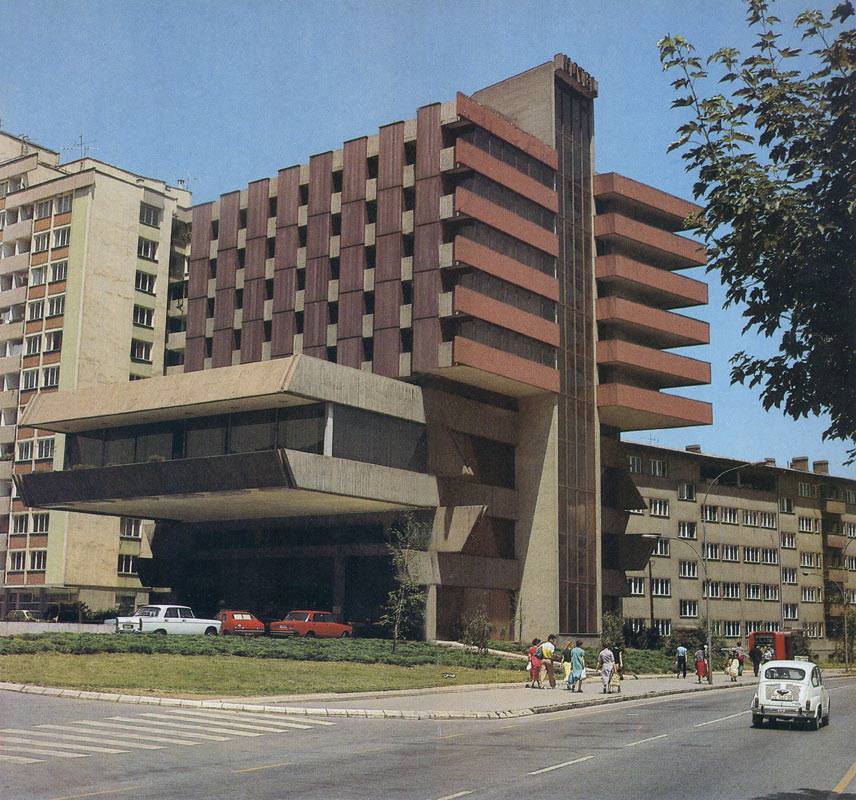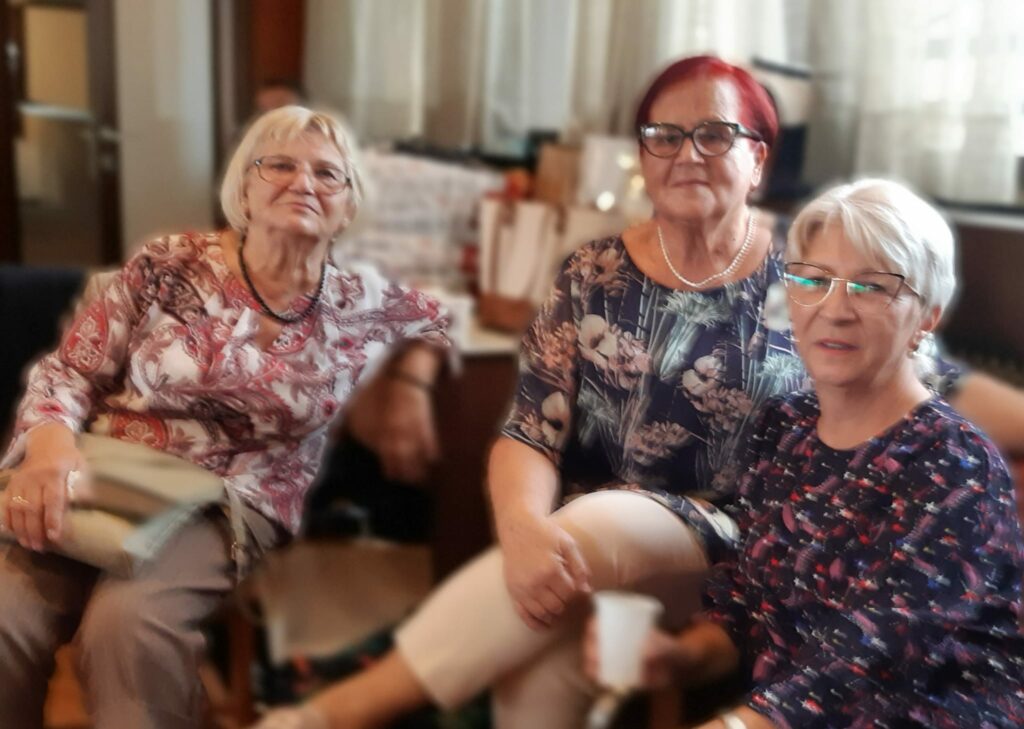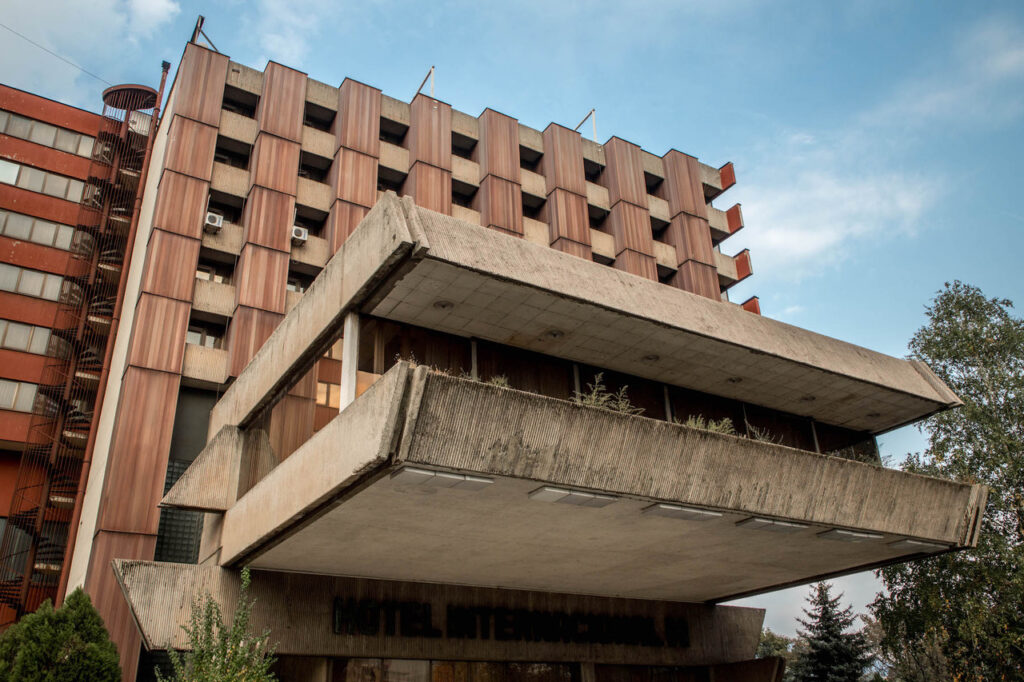Hotel Internacional, an architectural gem in the heart of Zenica, Bosnia and Herzegovina, has been closed for years due to neglect in the post-communist era. But it continues to live in urban memory and contemporary culture.

On September 23 last year, Sabiha Bajramović entered Zenica’s Hotel Internacional for the first time after over two decades. As one of the extras in the new film by the Bosnian director Dino Mustafić filmed in the city, she climbed to change her costume on the fourth floor of the once glamorous building with wide halls and extravagant chandeliers, now without electricity.
“I felt disappointment as soon as I came to the entrance,” she says.
The shabby interior of the building, to which Sabiha, a 76-year-old pensioner, owns many beautiful memories from her past, left a strong impression on her:
“The hotel, that has been in my heart ever since my youth days, is left to decay.”

Hotel Internacional turned 46 years old this year. It’s not much, but — unlike Sabiha — the extravagant modernist building doesn’t age well.
Built as part of the planned urbanisation of Zenica during socialist Yugoslavia, the hotel experienced many ups in the years before the war and many downs in the post-communist era. The downs led to its closure several years ago. Nevertheless, it is still part of the cultural identity of the city.
Architect Slobodan Jovandić designed it during the socialist regime when Zenica was transformed into a modern industrial centre of the former Yugoslavia. The hotel is characterised by overhangs extending from its central tower, which gives the visual effect of the concrete construction that defies gravity. It has seven floors, with underground parking, a garden, a terrace, various types of rooms and suites, a restaurant and two conference rooms.
Zenica’s Steel Mill (Željezara Zenica) was an important business unit in the former Yugoslavia, and Hotel Internacional — its oasis of luxury — has been hosting a high-class international clientele, as its name suggests. Even the former president of Yugoslavia, Josip Broz Tito, had a master suite in the hotel.
The hotel saw many official business lunches and dinners, but decadent late-night outings too. For Sabiha and many other citizens of Zenica, who affectionately call it “Inter,” it was a favourite party place: from graduation and retirement parties to weddings and New Year celebrations.
But the glory days of Hotel Internacional, which Sabiha remembers with nostalgia, are long gone.
After the war, the hotel management tried to continue its activities. However, without any investment in its maintenance, and after new hotels opened in the city, it lost its competitiveness.
It was slowly dying until it was closed in 2017. Željezara Zenica, the hotel’s owner, has been trying to sell it ever since. “My little masterpiece – I can’t believe that it doesn’t work and that nothing is being done about it,” Jovandić, the architect who designed the hotel, said at a recent public event in Zenica.
44-year-old Snežana Vidović, one of the actresses who starred in Mustafić’s film in which Sabiha was an extra, spent much time in the hotel during her childhood. Snežana’s mother was employed at the hotel for years, so for her, the hotel was a “second home” where she would do her homework, study and play. “I saw the hotel as a huge playground,” she says, recalling how she made gymnastics mats out of armchairs in the hotel’s TV room or helped the lady who worked in the laundry room, where she was fascinated by a large ironing roller.
Thirty years have passed since Snežana’s last visit to the hotel until last year’s filming. “At the moment, the hotel is just a distant memory of better times,” she adds explaining that the hotel’s interior is the same as she remembers it but is eroded by the ravages of time and is poorly maintained.
“Walking through the once crowded, now empty corridors and rooms was eerie. Many beautiful memories came back to me, but, in essence, I was very sad because there was no indication that life would return to the hotel.”
Apart from Mustafić’s film, which served as the backdrop of an imaginary home for the elderly, the hotel also finds its place in other cultural projects.
The hotel building was used as a model for the video game “Workers & Resources: Soviet Republic”. The game is a city-building simulation developed and released by the Slovak game studio 3Division which allows players to engage in urban and industrial planning in an imaginary communist state.
The acclaimed Croatian documentary series “Slumbering Concrete” (in Bosnian: “Betonski spavači”) that examines the former Yugoslavia’s socialist architecture presented Zenica in one of its episodes. The documentary shed new light on the city’s valuable and often overlooked architectural heritage.
In the film, the TV crew visits Hotel Internacional accompanied by Zenica-born architect Vedad Islambegović. “Modern rococo” is what the reporter called the hotel’s unusual interior, with its elongated interior terraces, socialist art on the walls and huge shiny ball chandeliers: “There’s a bit too much of everything,” he said.
The documentary pointed out the role of the local government in the decay of Hotel Internacional and other modernist wonders in the city. Ironically, the City of Zenica awarded this year’s prize of the city administration to the authors of “Slumbering Concrete” for affirming Zenica and strengthening its reputation in the country and the world.
In contrast to the negligence of the authorities, the efforts of Bosnians and Herzegovinians to celebrate the value of the city’s architecture are commendable.
Recent artistic projects such as Zenica Trilogy by Danica Dakić, Modernist Utopia by Selver Učanbarlić and Dino Jozić or Urban Herstories by Naš most Zenica Association have explored Zenica’s architectural heritage and brought it to the international audience.
There’s also Afan Abazović, a tour guide who organises walking tours through Zenica’s socialist modernist architecture, attended by fans of modernist architecture from countries worldwide.
Being in love with his city’s architecture, Afan uses social networks to promote his city’s architectural wonders, posting photos and facts about modernist buildings. British writer and researcher Richard Fawcus, who visited Zenica several times, took part in Afan’s tours and visited Hotel Internacional with him.

Richard has been photographing socialist architecture in Southeastern Europe for years and bringing travellers from the West to the Balkans, which is how he met Afan.
“Afan’s work is incredible, and I believe he is a credit to his city. But I also feel that there is a lot more that could be done to promote architectural tourism to Zenica,” says Richard, noting that sites like TripAdvisor don’t mention the city’s modernist architecture.
As an important part of the tourism potential, Hotel Internacional and other concrete jewels of Zenica deserve much systemic attention and investment.
“I think more broadly from a tourism perspective, if Zenica hopes to attract more visitors away from world-famous cities such as Mostar or Sarajevo, the most effective way of doing that would be by offering something completely different and unique… by telling them stories that they could only hear in Zenica,” Richard concludes.
The production of this story was supported by the Thomson Foundation as part of the Culture and Creativity for the Western Balkans project (CC4WBs). This story was created and maintained with the financial support of the European Union. Its contents are the sole responsibility of the author and do not necessarily reflect the views of the European Union.